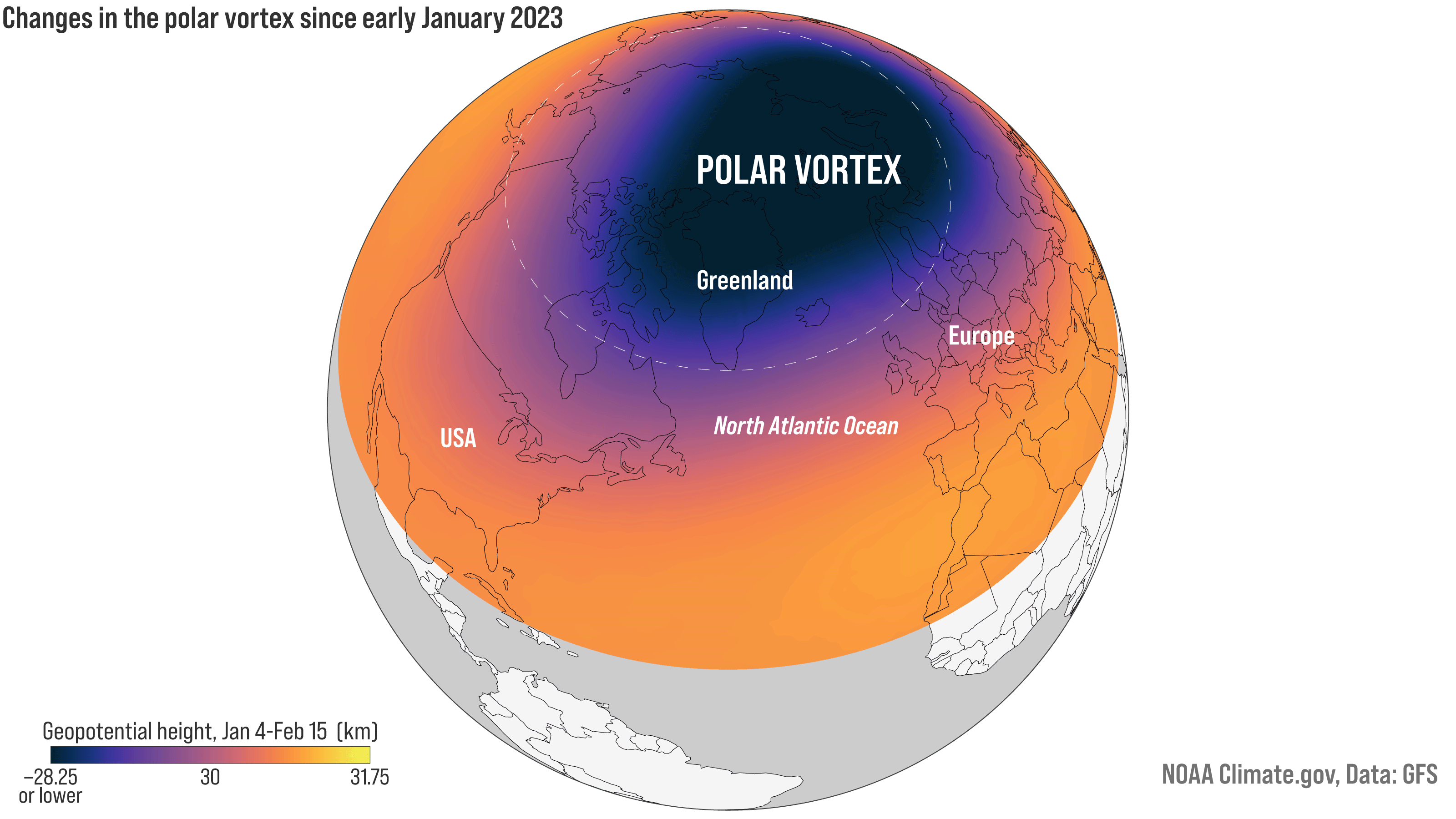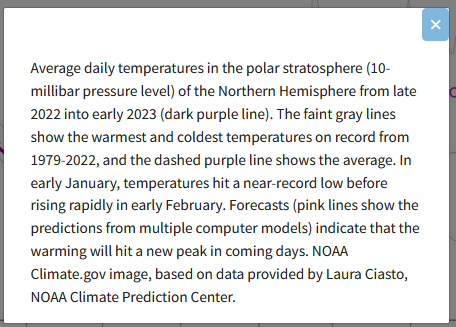Updated at 3:30 p.m. EST Saturday, February 18, 2023
Here is what we are paying attention to in the next 48 to 72 hours. The article also includes weather maps for longer-term outlooks and a five-day World weather forecast. The article also provides information on the current Sudden Stratospheric Warming (SSW) Event.
We start with the U.S. Information.
Short Range Forecast Discussion
NWS Weather Prediction Center College Park MD
306 PM EST Sat Feb 18 2023Valid 00Z Sun Feb 19 2023 – 00Z Tue Feb 21 2023
…Locally heavy snow to spread across the high terrain of the Northern
Rockies and Northwest…

| Information Note: This article is now set up so that all the maps should automatically update. The links are provided but should not be needed. The downside is that if you go back to a previous version the maps will have been updated and not be relevant to the date of the prior article but will be current information. The NWS twice-a-day 48-hour forecasts do not auto-update in this article. I do it and I can be late doing it. The link for the NWS updates is HERE. Most of our other articles will not be set up to auto-update so that prior versions of the article will be meaningful.
To read the new NOAA Four-Season Outlook Click HERE . Remember the easiest way to get back to the article you were reading is to hit the return arrow in the upper left of your screen. There are other ways. |
| It is mentioned in the NOAA Seasonal Outlook Discussion issued on February 16. But they were not very definitive about the impact of yet another Sudden Stratospheric Warming (SSW) event probably because it is hard to forecast the impact of these events on the ground. But HERE is a link to an article on this evolving event. One of the images below shows better in that article than when republished in our article, so if you want to see the fainter lines in that graphic, go to the link provided. The exact timing of the impacts at surface level is not clear at this time. A warming event in the stratosphere may or may not impact weather closer to the surface of the Earth. It usually does but where and when are difficult to predict. |
Now, the 48-Hour Forecast (It is a 48 to 72 Hour Forecast actually)
Daily weather maps. I try to keep the below three maps updated. The Day 1 map updates twice a day and the Day 2 and 3 maps update only once a day. I will be doing the updating during the period described in the title of the article but if you happen to read this article later, you can get updates by clicking HERE
TODAY (or late in the day the evening/overnight map will appear)
TOMORROW
NEXT DAY
This animation shows how things may play out over the next 60 hours. To update click here.
ATMOSPHERIC RIVERS
This tells us what is approaching the West Coast. Click HERE to update If I have not gotten around to doing the update. Here is some useful information about Atmospheric Rivers.
Continuation of the NWS Short Range Forecast (It is updated by NWS twice a day and these updates can be found here. We post at least one of those updates daily, sometimes both. The Highlights are shown in the lede paragraph of this article.
A vast majority of the country will have very little if any precipitation
this weekend and into the start of this coming week. However, potentially
heavy mountain snow forecast forecast for the Pacific Northwest and the
Northern Rockies. Northwesterly flow aloft around an eastern Pacific
upper-level ridge will allow for waves of moisture to enter the region.
Some of the highest snow accumulations are expected in the favored upslope
areas which may reach 2 feet prior to Tuesday. Lower elevations across
Idaho and western Montana may also experience lighter snowfall amounts.A chilly airmass is over much of the Deep South and East after yesterday’s
cold frontal passage. Temperatures will rebound to above normal values
across most of the country beginning tomorrow. Scattered showers are
expected to continue along the now stationary front over southern Florida.
Lastly, in terms of precipitation, light snow may traverse the Northern
Plains and Upper Midwest on Sunday, while shower chances enter Arizona and
New Mexico ahead of a churning upper-level low. Rain and snow showers are
possible for much of the Northeast on Monday.
Below is the current five-day cumulative forecast of precipitation (Updates can be found HERE)
Now we look at Intermediate-Term “Outlook” maps for three time periods. Days 6 – 10, Days 8 – 14, and Weeks 3 and 4. An outlook differs from a forecast based on how NOAA uses these terms in that an “outlook” presents information as deviation from normal and the likelihood of these deviations.
Below are the links to obtain updates and additional information. They are particularly useful if you happen to be reading this article significantly later than when it was published. I always try to provide readers with the source of the information in my articles.
| Days 6 – 10 (shown in Row 1) | Days 8 – 14 (Shown in Row 2) | Weeks 3 and 4 (Shown in Row 3 but updates only on Fridays) |
| https://www.cpc.ncep.noaa. gov/products/predictions/610day/ | https://www.cpc.ncep .noaa.gov/products/predictions/814day/ | https://www.cpc.ncep.noaa.gov/products/predictions/WK34/ |
Showing the actual maps. They should now update automatically. The Week 3 – 4 Outlook only updates on Fridays. So below is what I call the Intermediate-term outlook. On Fridays, it extends out 28 Days. That declines day by day so on Thursday it only looks out 22 days until the next day when the Week 3 – 4 Outlook is updated and this extends the outlook by one additional week.
| 6
– 10
|
|
|
| 8
– 14 |
|
|
| 3
– 4 |
|
|
HAZARDS OUTLOOKS
Click here for the latest complete Day 3 -7 Hazards forecast which updates only on weekdays. Once a week probably Monday or Tuesday I will update the images. I provided the link for readers to get daily updates on weekdays. Use your own judgment to decide if you need to update these images. I update almost all the images Friday Night for the weekend edition of this Weather Report. So normally readers do not need to update these images but if the weather is changing quickly you may want to.
Month to Date Information
Temperature month to date can be found at https://hprcc.unl.edu/products/maps/acis/MonthTDeptUS.png
Precipitation month to date can be found at https://hprcc.unl.edu/products/maps/acis /MonthPNormUS.png
World Forecast
Below are the 5-Day forecasts for temperature and precipitation. Updates and much additional information can be obtained HERE
This information is provided by the University of Maine. They draw upon many different sources. There is a lot of information available at the link provided. I have just provided two useful forecasts. There are probably over a hundred different forecasts available from this source.
Worldwide Tropical Forecast (This is a NOAA Product)
This graphic updates on Tuesdays) If it has not been updated, you can get the update by clicking here Readers will only have to do that if they are reading this article much later than the date of it being published.-
–
| I hope you found this article interesting and useful. |



This is the Author of these weather articles. Someone asked me what we know of the possible impacts of this SSW event. The best information I have is from the NWS CPC Week 3 – 4 Outlook issued yesterday. Here is what they said. “A sudden stratospheric warming (SSW) recently began which can manifest at the surface as a negative Arctic Oscillation (AO), however the SSW does not yet have a clear impact on the troposphere and forecasts of the AO from the Global Ensemble Forecast System (GEFS) and ECMWF models remain positive with considerable spread. Evolution of the SSW remains uncertain and influence from the SSW is not strongly considered.” So the potential impact to the U.S. seems minimal so far. At this point, I do not have information on the possible impacts on Europe. If I obtain additional information, I will include it in my Daily Weather Article. One additional comment. Most SSW events occur in January.